#science technology engineering and maths
Explore tagged Tumblr posts
Text
Tesla’s Wardenclyffe Tower: Built on Sound Math, Undone by Cost and Misunderstanding

Let’s set the record straight—Nikola Tesla’s Wardenclyffe Tower was a high-voltage experimental transmission system grounded in quarter-wave resonance and electrostatic conduction—not Hertzian radiation. And the math behind it? It was solid—just often misunderstood by people applying the wrong physics.
In May 1901, Tesla calculated that to set the Earth into electrical resonance, he needed a quarter-wavelength system with a total conductor length of about 225,000 cm, or 738 feet.
So Tesla’s tower design had to evolve during construction. In a letter dated September 13, 1901, to architect Stanford White, Tesla wrote: “We cannot build that tower as outlined.” He scaled the visible height down to 200 feet. The final structure—based on photographic evidence and Tesla’s own testimony—stood at approximately 187 feet above ground. To meet the required electrical length, Tesla engineered a system that combined spiral coil geometry, an elevated terminal, a 120-foot vertical shaft extending underground, and radial pipes buried outward for approximately 300 feet. This subterranean network, together with the 187-foot tower and carefully tuned inductance, formed a continuous resonant conductor that matched Tesla’s target of 738 feet. He described this strategy in his 1897 patent (No. 593,138) and expanded on it in his 1900 and 1914 patents, showing how to simulate a longer conductor using high-frequency, resonant components. Even with a reduced visible height, Tesla’s system achieved quarter-wave resonance by completing the rest underground—proving that the tower’s electrical length, not its physical height, was what really mattered.
Tesla calculated his voltages to be around 10 million statvolts (roughly 3.3 billion volts in modern SI), so he had to consider corona discharge and dielectric breakdown. That’s why the terminal was designed with large, smooth spherical surfaces—to minimize electric surface density and reduce energy loss. This was no afterthought; it’s a core feature of his 1914 patent and clearly illustrated in his design sketches.
Now, about that ±16 volt swing across the Earth—what was Tesla talking about?
He modeled the Earth as a conductive sphere with a known electrostatic capacity. Using the relation:
ε × P = C × p
Where:
ε is the terminal’s capacitance (estimated at 1,000 cm)
P is the applied voltage (10⁷ statvolts)
C is the Earth’s capacitance, which Tesla estimated at 5.724 × 10⁸ cm (based on the Earth’s size)
p is the resulting voltage swing across the Earth
Plugging in the numbers gives p ≈ 17.5 volts, which Tesla rounded to ±16 volts. That’s a theoretical 32-volt peak-to-peak swing globally—not a trivial claim, but one rooted in his framework.
Modern recalculations, based on updated geophysical models, suggest a smaller swing—closer to ±7 volts—using a revised Earth capacitance of about 7.1 × 10⁸ cm. But that’s not a knock on Tesla’s math. His original ±16V estimate was fully consistent with the cgs system and the best data available in 1901, where the Earth was treated as a uniformly conductive sphere.
The difference between 7 and 16 volts isn’t about wrong numbers—it’s about evolving assumptions. Tesla wrote the equation. Others just adjusted the inputs. His premise—that the Earth could be set into controlled electrical resonance—still stands. Even if the voltage swing changes. The vision didn’t.
Wouldn't that ±16V swing affect nature or people? Not directly. It wasn’t a shock or discharge—it was a global oscillation in Earth’s electric potential, spread evenly across vast distances. The voltage gradient would be tiny at any given point—far less than what’s generated by everyday static electricity. Unless something was specifically tuned to resonate with Tesla’s system, the swing had no noticeable effect on people, animals, or the environment. It was a theoretical signature of resonance, not a hazard. While some early experiments in Colorado Springs did produce disruptive effects—like sparks from metal objects or spooked horses—those involved untuned, high-voltage discharges during Tesla’s exploratory phase. Wardenclyffe, by contrast, was a refined and carefully grounded system, engineered specifically to minimize leakage, discharge, and unintended effects.
And Tesla wasn’t trying to blast raw power through the ground. He described the system as one that would “ring the Earth like a bell,” using sharp, high-voltage impulses at a resonant frequency to create standing waves. As he put it:
“The secondary circuit increases the amplitude only... the actual power is only that supplied by the primary.” —Tesla, Oct. 15, 1901
Receivers, tuned to the same frequency, could tap into the Earth’s oscillating potential—not by intercepting radiated energy, but by coupling to the Earth’s own motion. That ±16V swing wasn’t a bug—it was the signature of resonance. Tesla’s transmitter generated it by pumping high-frequency, high-voltage impulses into the Earth, causing the surface potential to oscillate globally. That swing wasn’t the energy itself—it acted like a resonant “carrier.” Once the Earth was ringing at the right frequency, Tesla could send sharp impulses through it almost instantly, and tuned receivers could extract energy.
So—was it feasible?
According to Tesla’s own patents and 1916 legal testimony, yes. He accounted for insulation, voltage gradients, tuning, and corona losses. His design didn’t rely on brute force, but on resonant rise and impulse excitation. Tesla even addressed concerns over losses in the Earth—his system treated the planet not as a passive resistor but as an active component of the circuit, capable of sustaining standing waves.
Wardenclyffe wasn’t a failure of science. It was a casualty of cost, politics, and misunderstanding. Tesla’s system wasn’t just about wireless power—it was about turning the entire planet into a resonant electrical system. His use of electrostatics, high-frequency resonance, and spherical terminals was decades ahead of its time—and still worth studying today.
“The present is theirs; the future, for which I really worked, is mine.” —Nikola Tesla
#nikola tesla#science#history#quotes#electricity#wireless#technology#mathematics#math#engineering#power#Wardenclyffe#ahead of his time#ahead of our time
81 notes
·
View notes
Text

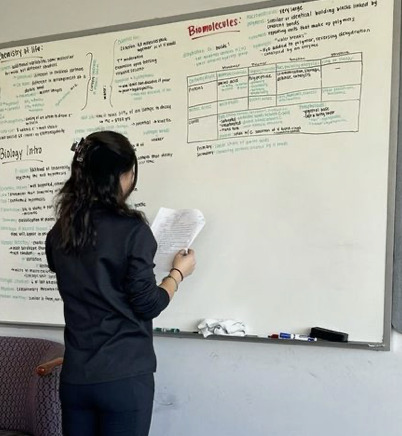







STEM girls. 🪐🔬🧪
#STEM#women in stem#academic weapon#student#rory gilmore aesthetic#moodboard#pinterest#beauty#maths#math#mathematics#science#technology#engineering#romantic academia#academia#dark academia#light academia#classic academia#study inspo#study motivation#vintage#aesthetic#pinterest moodboard
100 notes
·
View notes
Text


Did some art for a local science and technology fair!
34 notes
·
View notes
Text
youtube
How To Learn Math for Machine Learning FAST (Even With Zero Math Background)
I dropped out of high school and managed to became an Applied Scientist at Amazon by self-learning math (and other ML skills). In this video I'll show you exactly how I did it, sharing the resources and study techniques that worked for me, along with practical advice on what math you actually need (and don't need) to break into machine learning and data science.
#How To Learn Math for Machine Learning#machine learning#free education#education#youtube#technology#educate yourselves#educate yourself#tips and tricks#software engineering#data science#artificial intelligence#data analytics#data science course#math#mathematics#Youtube
21 notes
·
View notes
Text
so if Science, Technology, Engineering, and Maths equal STEM, then its logical counterpart would be LEAF (Literature, English, Arts, and Film) right?
it has the plant theme and everything
14 notes
·
View notes
Text








Absolutely the last posting for orders after this any posting is first come first serve Part one of two and last chance to DM and order any of these as quite few I've found are already out of print so going to be doing one big push to get as many duplicates as possible for flipping werk and retiring the ones I absolutely ordered for my self in first place any way, part two will contain what currently wearing on wardrobe + all rude funny phrases and equality pin + a preview on pile of them some already aquired duplicates of ones think ppl will want + all grab bag ones i didn't want but most def will let go crazy cheap to y'all. Yeah after the big order gonna empty two books onto my private room wall hanging so I can rotate them on me as see fit while opening up all space for all duplicates n randoms and will be a first come first serve based on stock system and no more order attempts so last call y'all see what ya like or if ones close or gives idea 💡 a show cartoon movie meme ECT tho also takeing funds up front now for the orders as I can't possibly front all that plus do the required duplicate attempt while seeing which ones simply are gone, if one you pick is gone you'll be sent 3 close options to it and then refunded if required so sorry in advance if it's gone. Personal id give at least two or 3 options that you want per order attempt just based on fact I've found alot go go gone city sadly.
When I get the current duplicates in book & randoms I'll post them as they are first come first serve y'all .
#dm me#enamel pins#pins#80s#90s#2000s#nickelodeon#cartoon network#Disney#anime#tv shows#movies#pc#nintendo#STEM#science#technology#engineering#math#religion jokes#dnd#cats#kitties#aliens#animals#dank memes#memes#internet#quotes
12 notes
·
View notes
Text
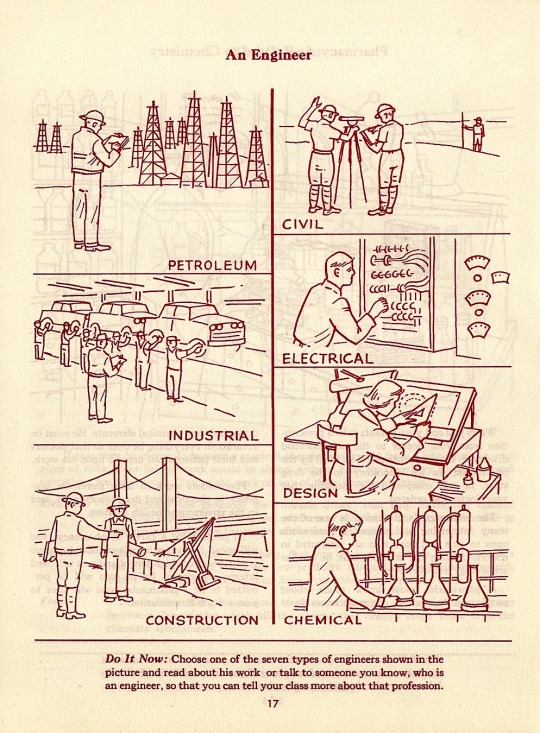
An engineer.
#We need engineers.#vintage illustration#engineers#engineering#science#math#technology#petroleum engineer#civil engineer#chemical engineer#computer engineer#electrical engineer#r&d#research & development#research#industry#mechanical engineer#biomedical engineer#aerospace engineer#vintage books#american industry
20 notes
·
View notes
Text
I know no one wants to hear this, but adding the A to make STEAM is actively hurting trying to introduce young girls to subjects previously gatekept from them
The entire point of STEM and specifically Women in STEM is to encourage kids to pursue nerdy school shit that they wouldn't otherwise. Go to the STEM club, kids! you'll build a tiny trebuchet, program a turtle in blujay, solder a flashlight yourselves, get help with your science fair poster! That's good shit, esp geared towards grade school girls when they're constantly told as they grow up that girls are just naturally worse at math, and computers are a boy thing, and all these fields are mostly men cuz that's just what men are good at and you'll probably be better in like, nursing or english or something more appropriate for your woman-ness.
The entire point of girl-centered STEM programs is to introduce them to the subjects young so learning them at a more advanced level later is not foreign, or discouraging, or just a boy thing cuz the societal pressure cut their interest at the root.
When you add the A for arts, practically no afterschool program is going to bother trying to teach kids (and girls) all that nerdy shit (INCLUDING fine arts, which is the POINT of the A) when they don't understand that shit themselves and could just start a STEAM program leaning heavily on the Arts and then adding a cute little "and crafts" to it. I see it in stores, too. A little paint-by-number style craft kit where you glue yarn in the shape of a rainbow was labeled "STEAM!" in bright pink. Sewing kits are labeled STEAM now.
Suddenly your "inclusive" for-girls mentorship program is shoehorning girls directly into the artsy-creative-handcrafts bullshit hole that Women in STEM was meant to take them out of in the first place.
Fine arts is so unbelievably important to teach to and foster in kids, but for fucks' sake, stop forcing girls into the shitty infantilizing version of it, especially with the movement that's supposed to do the opposite
177 notes
·
View notes
Text
By: Olga Khazan
Published: Feb 18, 2018
Though their numbers are growing, only 27 percent of all students taking the AP Computer Science exam in the United States are female. The gender gap grows worse from there: Just 18 percent of American computer-science college degrees go to women. This is in the U.S., where many college men proudly describe themselves as “male feminists” and girls are taught they can be anything they want to be.
Meanwhile, in Algeria, 41 percent of college graduates in the fields of science, technology, engineering, and math—or STEM, as it’s known—are female. There, employment discrimination against women is rife, and women are often pressured to make amends with their abusive husbands.
According to a report that I covered a few years ago, Jordan, Qatar, and the United Arab Emirates were the only three countries in which boys were significantly less likely to feel comfortable working on math problems than girls were. In all of the other nations surveyed, girls were more likely to say they feel “helpless while performing a math problem.”
So what explains the tendency for nations that have traditionally less gender equality to have more women in science and technology than their gender-progressive counterparts do?

[ A scatter plot of countries based on their number of female STEM graduates and their Global Gender Gap Index (y-axis), a measure of opportunities for women (Psychological Science) ]
According to a new paper published in Psychological Science by the psychologists Gijsbert Stoet, of Leeds Beckett University, and David Geary, of the University of Missouri, it could have to do with the fact that women in countries with higher gender inequality are simply seeking the clearest possible path to financial freedom. And typically, that path leads through STEM professions.
The issue doesn’t appear to be girls’ aptitude for STEM professions. In looking at test scores across 67 countries and regions, Stoet and Geary found that girls performed about as well or better than boys did on science in most countries, and in almost all countries, girls would have been capable of college-level science and math classes if they had enrolled in them.
But when it comes to their relative strengths, in almost all the countries—all except Romania and Lebanon—boys’ best subject was science, and girls’ was reading. (That is, even if an average girl was as good as an average boy at science, she was still likely to be even better at reading.) Across all countries, 24 percent of girls had science as their best subject, 25 percent of girls’ strength was math, and 51 percent excelled in reading. For boys, the percentages were 38 for science, 42 for math, and 20 for reading. And the more gender-equal the country, as measured by the World Economic Forum’s Global Gender Gap Index, the larger this disparity between boys and girls in showing science to be their best subject. (The most gender-equal countries are the typical snowy utopias you hear about, such as Sweden, Finland, and Iceland. Turkey and the United Arab Emirates rank among the least equal, according to the Global Gender Gap Index.)
The gap in reading “is related at least in part to girls’ advantages in basic language abilities and a generally greater interest in reading; they read more and thus practice more,” Geary told me.
What’s more, the countries that minted the most female college graduates in fields such as science, engineering, or math were also some of the least gender-equal countries. Stoet and Geary posit that this is because the countries that empower women also empower them, indirectly, to pick whatever career they’d enjoy most and be best at.
“Countries with the highest gender equality tend to be welfare states,” they write, “with a high level of social security.” Meanwhile, less gender-equal countries tend to also have less social support for people who, for example, find themselves unemployed. Thus, the authors suggest, girls in those countries might be more inclined to choose STEM professions because they offer a more certain financial future than, say, painting or writing.
When the study authors looked at the “overall life satisfaction” rating of each country—a measure of economic opportunity and hardship—they found that gender-equal countries had more life satisfaction. The life-satisfaction ranking explained 35 percent of the variation between gender equality and women’s participation in STEM. That correlation echoes past research showing that the genders are actually more segregated by field of study in more economically developed places.
The upshot of this research is neither especially feminist nor especially sad: It’s not that gender equality discourages girls from pursuing science. It’s that it allows them not to if they’re not interested.
The findings will likely seem controversial, because the idea that men and women have different inherent abilities is used by some to argue that we should forget trying to recruit more women to the STEM fields. But, as Janet Shibley Hyde, a gender-studies professor at the University of Wisconsin who wasn’t involved with the study, put it to me, that’s not quite what’s happening here.
“Some would say that the gender STEM gap occurs not because girls can’t do science, but because they have other alternatives, based on their strengths in verbal skills,” she said. “In wealthy nations, they believe that they have the freedom to pursue those alternatives and not worry so much that they pay less.”
Instead, this line of research, if it’s replicated, might hold useful takeaways for people who do want to see more Western women entering STEM fields. In this study, the percentage of girls who excelled in science or math was still larger than the number of women who were graduating with STEM degrees. That means there’s something in even the most liberal societies that’s nudging women away from math and science, even when those are their best subjects. The women-in-STEM advocates could, for starters, focus their efforts on those would-be STEM stars.
Then again, it could just be that, feeling financially secure and on equal footing with men, some women will always choose to follow their passions, rather than whatever labor economists recommend. And those passions don’t always lie within science.
--
Abstract
The underrepresentation of girls and women in science, technology, engineering, and mathematics (STEM) fields is a continual concern for social scientists and policymakers. Using an international database on adolescent achievement in science, mathematics, and reading ( N = 472,242), we showed that girls performed similarly to or better than boys in science in two of every three countries, and in nearly all countries, more girls appeared capable of college-level STEM study than had enrolled. Paradoxically, the sex differences in the magnitude of relative academic strengths and pursuit of STEM degrees rose with increases in national gender equality. The gap between boys' science achievement and girls' reading achievement relative to their mean academic performance was near universal. These sex differences in academic strengths and attitudes toward science correlated with the STEM graduation gap. A mediation analysis suggested that life-quality pressures in less gender-equal countries promote girls' and women's engagement with STEM subjects.
==
The definition of "STEM" is deceptive. It selects for primarily male-dominated "things" areas, while excluding female-dominated "life" domains, such as medicine, psychology, nursing, biology and environmental sciences.
Despite what people assume, "STEM" does not include all the sciences.
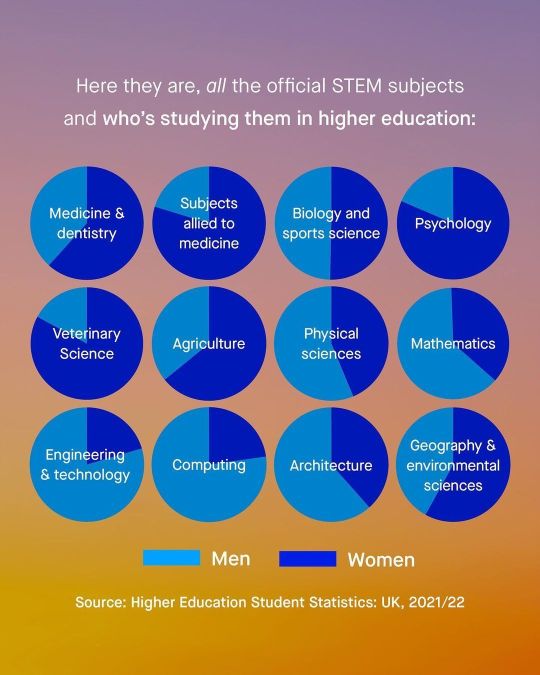
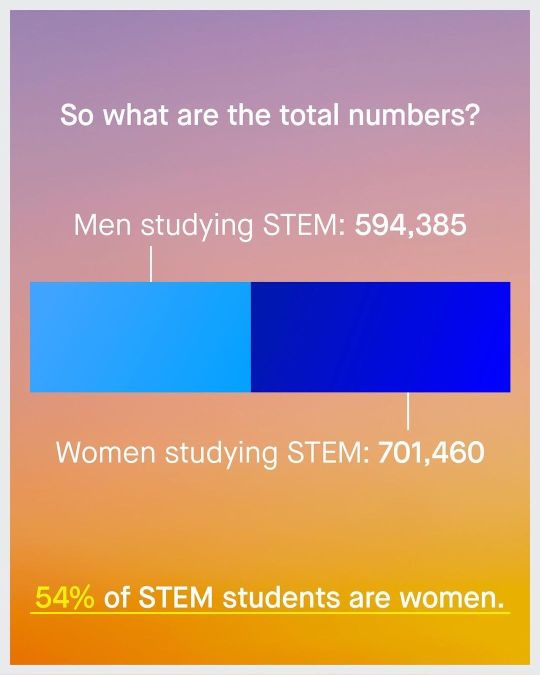

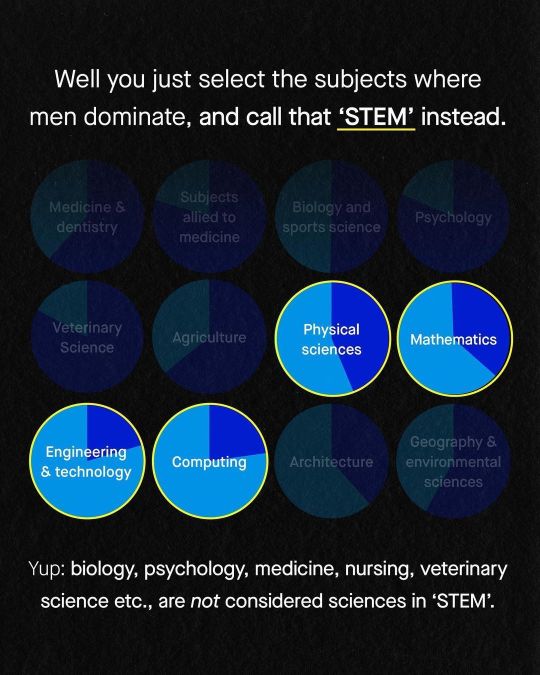
When you factor in all of the sciences, women outnumber men. Meaning, all the handwringing over "women in STEM" is complete nonsense.
Especially when it turns out that gender - that is, average sex-differences - aren't a "social construct." The average differences between men and women are real, demonstrable, measurable, and they're larger in more equal societies, because individuals have greater opportunity to do what they really want, without external pressures like financial demands. This has been studied repeatedly; see below.
Abstract
We investigated sex differences in 473,260 adolescents’ aspirations to work in things-oriented (e.g., mechanic), people-oriented (e.g., nurse), and STEM (e.g., mathematician) careers across 80 countries and economic regions using the 2018 Programme for International Student Assessment (PISA). We analyzed student career aspirations in combination with student achievement in mathematics, reading, and science, as well as parental occupations and family wealth. In each country and region, more boys than girls aspired to a things-oriented or STEM occupation and more girls than boys to a people-oriented occupation. These sex differences were larger in countries with a higher level of women’s empowerment. We explain this counter-intuitive finding through the indirect effect of wealth. Women’s empowerment is associated with relatively high levels of national wealth and this wealth allows more students to aspire to occupations they are intrinsically interested in. Implications for better understanding the sources of sex differences in career aspirations and associated policy are discussed.
Abstract
Preferences concerning time, risk, and social interactions systematically shape human behavior and contribute to differential economic and social outcomes between women and men. We present a global investigation of gender differences in six fundamental preferences. Our data consist of measures of willingness to take risks, patience, altruism, positive and negative reciprocity, and trust for 80,000 individuals in 76 representative country samples. Gender differences in preferences were positively related to economic development and gender equality. This finding suggests that greater availability of and gender-equal access to material and social resources favor the manifestation of gender-differentiated preferences across countries.
Abstract
Sex differences in personality have been shown to be larger in more gender equal countries. We advance this research by using an extensive personality measure, the IPIP-NEO-120, with large country samples (N > 1000), from 22 countries. Furthermore, to capture the multidimensionality of personality we measure sex differences with a multivariate effect size (Mahalanobis distance D). Results indicate that past research, using univariate measures of effect size, have underestimated the size of between-country sex differences in personality. Confirming past research, there was a strong correlation (r = .69) between a country's sex differences in personality and their Gender Equality Index. Additional analyses showed that women typically score higher than men on all five trait factors (Neuroticism, Extraversion, Openness, Agreeableness and Conscientiousness), and that these relative differences are larger in more gender equal countries. We speculate that as gender equality increases both men and women gravitate towards their traditional gender roles.
Abstract
Previous research suggested that sex differences in personality traits are larger in prosperous, healthy, and egalitarian cultures in which women have more opportunities equal with those of men. In this article, the authors report cross-cultural findings in which this unintuitive result was replicated across samples from 55 nations (N = 17,637). On responses to the Big Five Inventory, women reported higher levels of neuroticism, extraversion, agreeableness, and conscientiousness than did men across most nations. These findings converge with previous studies in which different Big Five measures and more limited samples of nations were used. Overall, higher levels of human development--including long and healthy life, equal access to knowledge and education, and economic wealth--were the main nation-level predictors of larger sex differences in personality. Changes in men's personality traits appeared to be the primary cause of sex difference variation across cultures. It is proposed that heightened levels of sexual dimorphism result from personality traits of men and women being less constrained and more able to naturally diverge in developed nations. In less fortunate social and economic conditions, innate personality differences between men and women may be attenuated.
Abstract
Using data from over 200,000 participants from 53 nations, I examined the cross-cultural consistency of sex differences for four traits: extraversion, agreeableness, neuroticism, and male-versus-female-typical occupational preferences. Across nations, men and women differed significantly on all four traits (mean ds = -.15, -.56, -.41, and 1.40, respectively, with negative values indicating women scoring higher). The strongest evidence for sex differences in SDs was for extraversion (women more variable) and for agreeableness (men more variable). United Nations indices of gender equality and economic development were associated with larger sex differences in agreeableness, but not with sex differences in other traits. Gender equality and economic development were negatively associated with mean national levels of neuroticism, suggesting that economic stress was associated with higher neuroticism. Regression analyses explored the power of sex, gender equality, and their interaction to predict men's and women's 106 national trait means for each of the four traits. Only sex predicted means for all four traits, and sex predicted trait means much more strongly than did gender equality or the interaction between sex and gender equality. These results suggest that biological factors may contribute to sex differences in personality and that culture plays a negligible to small role in moderating sex differences in personality.
Abstract
Men's and women's personalities appear to differ in several respects. Social role theories of development assume gender differences result primarily from perceived gender roles, gender socialization and sociostructural power differentials. As a consequence, social role theorists expect gender differences in personality to be smaller in cultures with more gender egalitarianism. Several large cross-cultural studies have generated sufficient data for evaluating these global personality predictions. Empirically, evidence suggests gender differences in most aspects of personality-Big Five traits, Dark Triad traits, self-esteem, subjective well-being, depression and values-are conspicuously larger in cultures with more egalitarian gender roles, gender socialization and sociopolitical gender equity. Similar patterns are evident when examining objectively measured attributes such as tested cognitive abilities and physical traits such as height and blood pressure. Social role theory appears inadequate for explaining some of the observed cultural variations in men's and women's personalities. Evolutionary theories regarding ecologically-evoked gender differences are described that may prove more useful in explaining global variation in human personality.
The only way to force arbitrarily equal outcomes - for no better reason than to say you achieved it - is to remove or limit people's choices. Because the places where men's and women's outcomes are the most equal is where they're both toiling in the rice-fields for 12 hours a day.
#Olga Khazan#science#STEM#science technology engineering math#technology#engineering#math#women in STEM#gender equality#egalitarian#sex differences#gender differences#religion is a mental illness
14 notes
·
View notes
Text

Happy International Women's Day 2025, especially for women in the STEM field. Being a part of shaping the STEM field, is beyond impressing. 🥼🥽🧤⚛️🧬🧪🦖👩🚀👩🏻🚀👩🏼🚀👩🏽🚀👩🏾🚀👩🏿🚀
#women in stem#stemblr#stem#stem academia#stem aesthetic#stem student#stem studyblr#women's day#international women's day#smart women#science#technology#engineering#mathematics#math art#maths
7 notes
·
View notes
Text

Women in FLOWER
F - fashion - the examination of the economic, social, and cultural impact of clothing and accessories. For example—Vivienne Westwood (Chase Rutherford. - honorary gay).
L - literature - the analysis of written works, especially themes, characters, symbolism, language, structure, historic, and cultural. For example—Margaret Atwood.
O - oratory - the art of public speaking, focused on delivering a message to the audience with a goal of informing, persuading, and/or inspiring. For example—Michelle Obama.
W - writing - the analyzing of texts, and figuring out the structure and how they affect the readers. For example—Emily Dickinson.
E - English - the study, analysis, and exploration of English literature through texts. For example—Jane Austen.
R - rehabilitation - the process of bringing an individual back to the fullest possible degree of their independence. For example— Mary McMillan (also me, as I’m going through this rn 😭).
Women in STEM
S - science - the learning and understanding of the world around us, through observation, experimentations, and analysis. For example— Marie curie.
T - technology- the understanding about how scientific knowledge and ideas are used to solve problems and improve our lives, often through tools, devices, and systems. For example— Katherine Johnson.
E - engineering - the application of science and mathematics to solve real-world problems and phenomena’s by creating products, systems, and/or processes. For example—Mary Jackson.
M - mathematics - the study of numbers, shapes, and their relationship, along with the use of symbols and rules to understand. For example—Dorothy Vaughan.
Women in LEAF
L - law - the study that explores the nature or law and legal principles and systems. For examples—Loretta Lynch.
E - education - the study of how people learn and how to teach them best. For example—Malala Yousafzai.
A - art - study of various aspects of art including visual arts (painting, drawing, sculpturing, etc.), art history, and design— to help develop skills and knowledge of art. For example—Frida Kahlo.
F - film - understanding how films work as a form of art and media, including the history, technique, and how they are interpreted. For example—Sofia Coppola.
#hamzahthefantastic#chase rutherford#women#womensfashion#study motivation#study blog#study aesthetic#fashion#literature#oratory#writing#English#reflection#reflecting#science#technology#tech#engineering#engineer#mathematics#math#study of law#law#education#educate yourselves#art#artwork#original art#film#film photography
5 notes
·
View notes
Text











As a high school science teacher, I can’t wait to dive into this LEGO Ideas collectible display model on The Evolution of STEM! 🔬🧬🍎
The 879-piece set features a buildable base in the shape of an open book topped by mini builds that represent historic innovations – from an early car and a home computer to the NASA Voyager Probe. Turning a dial also adds a fun movable element to the mix, making a 3D replica of a carbon atom float upwards and a DNA strand rotate. Also included are minifigures of 3 famous scientists: Marie Curie (the “Mother of Modern Physics”), Sir Isaac Newton (leader of the Scientific Revolution), and George Washington Carver (a pioneering agricultural scientist). All in all, it’s a perfect set to add to my classroom!
#collecting#collector#collectibles#collection#lego#legos#lego sets#lego ideas#stem#stem academia#stem toys#stemblr#science#technology#engineering#math#mathematics#marie curie#isaac newton#george washington carver#minifigures#lego minifigures#nasa#dna#evolution#high school teacher#high school#teacher#science teacher#physics
3 notes
·
View notes
Text
I love women in stem
do YOU 🫵 love women in stem??
#riv’s stuff#women in stem#stem#feminism but as it should be#honoring the countless women whose discoveries and inventions made possible the world we know today#ada lovelace#hedy lamarr#cecilia payne#women in science#astrophysics#science#technology#engineering#mathematics#math#annie jump canon#cecilia payne gaposhkin#hypatia#sofia kavalevskaya#i think thats her name#elizabeth blackwell#theres a serious dearth of discussions of scientific women here#it makes me sad#pls if you know any more tag them#rosalind franklin#katherine johnson#dorothy vaughan#barbara mcclintock#marie curie#Lisa meitner
3 notes
·
View notes
Text
#women in stem#woman in stem#polls#science#technology#engineering#maths#women#dasloddl polls#science side of tumblr#poll#biology#chemistry#physics#medicine#computer science#statistics
22 notes
·
View notes
Text
i find it silly when people bash on experts as if math, science, and engineering are not the backbones of technological progression
do you use social media? thousands of electrical and software standards allowed you to
are you inside a building? structural engineers figured out all the math to make sure that building is as stable as possible
do you eat?? biotechnology, logistics, and farming are all things that have iteratively improved the ability for someone to eat and what they eat
i the notion of some underground nerd society that keeps the world in check is cool and all but i don't get the vilification
6 notes
·
View notes
Text
We are a social app built for people to share and celebrate everything bright & nerdy. We specialize in content related to engineering, medicine, comics, art, architecture, science, anime, gaming, and more. We plan to be the biggest content delivery system for everything nerdy.


#social media#anime#comics#artwork#business#economics#makeup#science#biology#engineering#physics#maths#computer#film#architecture#diy#biochemistry#chemistry#astronomy#geology#oceanography#botany#neuroscience#zoology#Social Science#psychology#technology#software#civil engineering#chemical engineering
3 notes
·
View notes